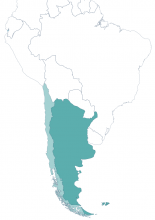Manuel Tamayo was born in Santiago (Chile) on 6th May 1952 to his parents, Manuel and Juana. He grew up in the old neighbourhood of Quinta Normal within a family that identified itself as leftist. He completed his secondary education at the Darío Salas Lyceum, where he was the leader of the Student Council and joined the Socialist Youth. When Manuel moved to the Macul suburbs with his family, he became politically active in new neighbourhoods and participated in Salvador Allende's 1970 presidential campaign. Having completed secondary school, he travelled down south to study sociology at the University of Concepción while also completing a commercial engineering course on the side.
Manuel headed for Santiago on 9th September 1973 to attend his sister's wedding. His trip to the capital coincided with the day of the coup d'état that deposed the Unidad Popular (Popular Unity) government of Salvador Allende on 11th September. Manuel decided against returning to Concepción and helped to find a place of refuge for his persecuted companions. He immediately began working with Ricardo Lagos Salinas and Carlos Lorca, who were members of the Political Commission of the Socialist Party's Central Committee. He helped to build networks between the Commission for Consensus and the Socialist Party leadership. Pinochet's intelligence agency, the Dirección de Inteligencia Nacional (Directorate of National Intelligence, DINA) detained the socialist leaders in June 1975.
Manuel travelled to Mendoza, Argentina on 12th March 1976 via the Paso Libertadores: the main route that crosses the Andean border between Argentina and Chile. He went to live with a friend, Juan Humberto Hernández Zaspe, who was one of his Macul neighbours and a socialist militant. Juan had arrived in Mendoza in September 1975, escaping the persecution against Socialist Party members. Manuel wrote to his family to tell them that they were being followed and spied on. Alongside another socialist friend, Luis Gonzalo Muñoz Velásquez, he solicited protection from the United Nations High Commission for Refugees (UNHCR). Meanwhile, the DINA raided Juan Hernández's family home in Chile.
On 3rd April 1976, Manuel Tamayo, Luis Muñoz, and Juan Hernández were arrested upon leaving their house on Belgrado Street, where Luis' brother, Alex Muñoz Velásquez also lived with his wife and other Chileans. Alex declared that he was with his brother at around 4pm on 3rd April before going out with his wife. Upon returning home, he spoke to Luis Cerda, another resident of the house, who informed Alex that his brother, Luis, and his friends, Juan Hernández and Manuel Tamayo, had been arrested. He walked to the hotel opposite where he observed the operation. Heavily armed military officers arrived in a military truck, accompanied by two private cars and people dressed as civilians. One of the cars was a white Peugeot with a Chilean number plate. Luis saw his brother standing up in the back of the truck. The officers made Luis duck down before the convoy drove off.
The following day, Alex Muñoz Velásquez contacted the lawyer, Carlos Estévez who helped him with his search efforts. Alex had previously been arrested and was bound and handcuffed in various places. He was released, thanks to his lawyer, on the condition that he left the country in 30 days. In Chile, Manuel Tamayo's brother-in-law, Rafael Del Río Carrasco, received a phone call on 25th April 1976. A woman, whose voice he did not recognise, mentioned that Manuel was in Chile in an unknown place called 'Monte Maravilla'. A Chilean military police officer, or Carabinero, told Manuel's mother that her son was held at the DINA's secret prison, 'Cuatro Álamos'. They confirmed this information with the Chilean human rights organisation, the Vicaría de la Solidaridad (Vicariate of Solidarity).
Juan Carlos Feres Nazarola was arrested by DINA agents on 15th April 1976 and driven to the DINA's most important secret prison, 'Villa Grimaldi'. He recounted that, around the last week of April, he was left in a room with a bunk bed, separated by dividers that did not reach the ceiling. A short while later, another detainee, who was in a poor physical state, arrived and occupied the bed on the other side of the divider for two or three days. It was the socialist, Luis Muñoz, who told Juan Nazarola that the Argentine and Chilean police had arrested him, together with Jesús Tamayo and Hernández Zaspe. They were taken to Chile in the back of the truck, handcuffed, bound, and covered in tarpaulin. They exchanged details in case one of them managed to survive. After he was released, Feres informed the lawyer, Jaime Castillo Velasco. Myrian Tamayo Martínez filed a writ of amparo in Manuel's favour in July 1976, which was rejected (Rol 329-76). The 6th Tribunal opened the cases Rol 93.377 and 94.299 for the forced disappearance of Manuel Tamayo Martínez and Luis Muñoz Velásquez. The family filed a petition of presumed misfortune (presunta desgracia) through the Chilean legal system during the dictatorship. The cases of Manuel Tamayo Martínez and Luis Muñoz Velásquez were dismissed on 18th October 1976 and 4th January 1977, respectively.
On 5th May 2000, the sisters of Manuel Tamayo, Juan Hernández, and Luis Muñoz filed a lawsuit against the former Chilean dictator, Augusto Pinochet Ugarte, and the former head of the DINA, Manuel Contreras which led to the criminal case, Rol 2182-98 "Condor". The sentence, pronounced by Minister Mario Carroza on 21st September 2018, condemned the former DINA officials, Pedro Espinoza, Raúl Iturriaga, and Christoph Willike. On 25th July 2022, a judgement by Santiago's Appeals Court increased the officers' prison sentence to 20 years for the kidnapping of the three victims and Jorge Fuentes Alarcón.


